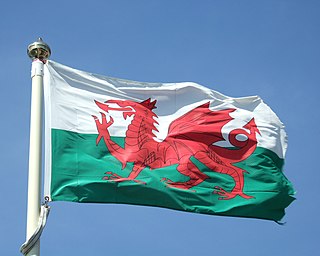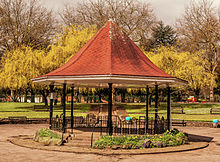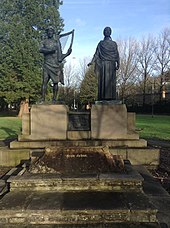
"Hen Wlad Fy Nhadau" is the unofficial national anthem of Wales. The title, taken from the first words of the song, means "The Old Land of My Fathers" in Welsh, usually rendered in English as simply "Land of My Fathers". The words were written by Evan James and the tune composed by his son, James James, both residents of Pontypridd, Glamorgan, in January 1856. The earliest written copy survives and is part of the collections of the National Library of Wales.

Pontypridd is a town and a community in Rhondda Cynon Taf, Wales.

Evan James, was a Welsh weaver and poet from Pontypridd, originally from Caerphilly, Wales, who wrote the lyrics of "Hen Wlad Fy Nhadau", the national anthem of Wales.
"Bro Gozh ma Zadoù" is the anthem of Brittany. It is sung to the same tune as that of the national anthem of Wales, "Hen Wlad Fy Nhadau", and has similar lyrics. The Cornish anthem, "Bro Goth Agan Tasow", is also sung to the same tune.

James James (1832–1902) was a Welsh harpist and musician from Hollybush, Blackwood, Wales. He composed the tune of the Welsh national anthem Hen Wlad fy Nhadau. Today, the same tune is also used for the Breton anthem, Bro Gozh ma Zadoù, and the Cornish anthem, Bro Goth agan Tasow.

The River Taff is a river in Wales. It rises as two rivers in the Brecon Beacons; the Taf Fechan and the Taf Fawr before becoming one just north of Merthyr Tydfil. Its confluence with the River Severn estuary is in Cardiff.
Events from the year 1856 in the United Kingdom.

John Owen, also known by his bardic name Owain Alaw Pencerdd, was a Welsh-language poet and also a musician.
Côr Meibion Pontypridd is a male voice choir from the Pontypridd area of the Rhondda Cynon Taf, Wales. It was formed in 1949 as a traditional Welsh singing choir and is based in Pwllgwaun, a suburb of Pontypridd.

The national symbols of Wales include various official and unofficial images and other symbols.

Thomas Williams was a Welsh rugby union forward who played club rugby for Cardiff and Pontypridd and international rugby for Wales. A solicitor by profession, Williams would later become a national selector for the Welsh Rugby Union. Williams was also responsible for suggesting the singing of the Welsh national anthem in a match in 1905, the first time a national anthem was sung before a sporting event.

Trallwn is a district, and as Trallwng, an electoral ward, within the town of Pontypridd, Rhondda Cynon Taf, South Wales, sited along the banks of the River Taff and falling within the historic parish of Eglwysilan. Trallwn comprises the subdistricts of Coedpenmaen (Coed-Pen-Maen), Ynysangharad and Pontypridd Common. Until recently Trallwn was also home to the famous Brown Lenox (Newbridge) Chain & Anchor Works at Ynysangharad, which was recently demolished. Also at Ynysangharad are some of the last remains of the Glamorganshire Canal which was used to transport coal and iron from the South Wales Valleys to the city of Cardiff. Ynysangharad is also home to Pontypridd's War Memorial Park - Ynysangharad Park.

Tich Gwilym, born Robert Gwilliam, was a Welsh rock guitarist who was most notable for his Hendrix inspired version of the Welsh national anthem, Hen Wlad Fy Nhadau, considered one of the most famous renditions of the song.

Robert Rees was a Welsh tenor and musician. He was a successful competitor at eisteddfodau for which he adopted the pseudonym Eos Morlais, and in 1867 he won the main prize as a vocalist at the National Eisteddfod of Wales. He was recognised as one of the leading Welsh soloists of his time.

Rhondda Cynon Taf is a county borough in South Wales. It is located to the north-west of Cardiff and covers an area of 424 km2 (164 sq mi). In 2021 the population was approximately 237,500.

Rhondda Cynon Taf is a county borough in South Wales. It is located to the north-west of Cardiff and covers an area of 424 km2 (164 sq mi). In 2021 the population was approximately 237,500.

The Welsh National Memorial Park is a war memorial in Langemark near Ypres (Belgium) for soldiers of World War I, located near the Pilkem Ridge in the former Ypres Salient. It commemorates the service of men and women of Welsh origin, wherever they served during the Great War as part of the Allied Powers, as well as the non-Welsh soldiers serving in Welsh formations.

The Big Welsh Bite Food Festival is an annual food festival that is held in Pontypridd.

Rhondda Cynon Taf is a county borough in South Wales. It is located to the north-west of Cardiff and covers an area of 424 km2 (164 sq mi). In 2021 the population was approximately 237,500.
















